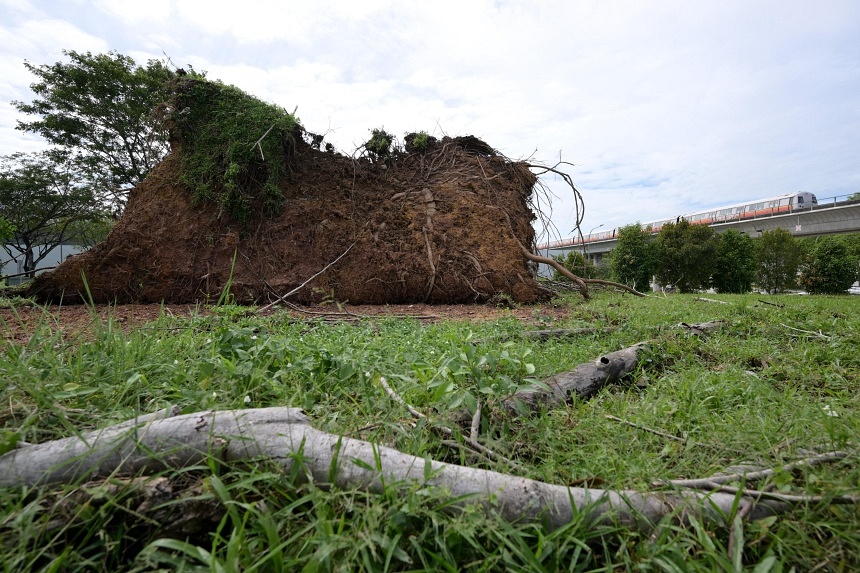
Trees were uprooted in Choa Chu Kang Grove after a heavy storm battered Singapore on the night of Sept 17.
ST PHOTO: NG SOR LUAN
Fatimah Mujibah
Sep 18, 2024,
SINGAPORE – The storm that swept into Singapore on Sept 17 lasted barely an hour, but left its mark across the island.
From Tampines in the east to Mount Faber in the south and Yishun in the north, netizens took to Facebook, Instagram and TikTok to document felled trees and broken branches strewn over roads.
There were also other unusual instances, such as a pair of trousers seen flying among high-rise buildings, pool furniture flying across and landing in the pool and various tableware pieces flying at an outdoor restaurant as patrons attempted to enjoy their meal.
Elsewhere in the region, Malaysia and Brunei were also affected by the extreme winds and rainfall. The Malaysian island of Penang had more than 200 toppled trees over two days from Sept 15, while Brunei’s fire and rescue department personnel attended to 72 emergency calls over fallen trees and 20 calls over roofs blown off on Sept 17.
Dr Matthias Roth, a professor of urban climatology at the National University of Singapore’s Department of Geography, said the severe weather “had many of the characteristics of a typical Sumatra squall, which is usually accompanied by a sudden increase in wind speed, gustiness and heavy rainfall”.
Just a day earlier, the National Environment Agency’s Meteorological Service Singapore (MSS) had warned that the Republic might experience the effects of such squalls, with widespread thundery showers and gusty winds on a few days in the next two weeks, and more rainfall expected at the end of the month
The Straits Times looks at what Sumatra squalls are, how this weather phenomenon affects Singapore and the rest of South-east Asia and if Singapore can expect to see more of such weather in the upcoming months.
What are Sumatra squalls and what causes them?
Sumatra squalls are a common and vigorous line of thunderstorms travelling rapidly towards the South China Sea.
“The causes of this phenomenon are complex and include convection, which is an upward transport of heat from the surface into the atmosphere, over the warm waters of the Malacca Strait, and converging land breezes passing between Sumatra and the Malay Peninsula,” said Prof Roth.
“Besides intense convection, Sumatra squalls also possess strong vertical wind shear – a variation in wind speed at a height which, in combination, results in heavy rainfall and strong winds.”
Sumatra squalls typically last for a few hours after forming early in the morning or at night and may occur at any time of the year, resulting in heavy rainfall. The squalls are most common during inter- and South-west monsoon seasons, such as April to May, and October to November.
Prof Roth added that squalls affect Singapore a few days every month during this period, occurring overnight or in the morning.
During this period, severe flooding, fallen trees, damage to objects and properties and power outages can happen.
The disruptive weather system can affect up to 85 million people in the region, according to a study published in 2018.
When was the last time Singapore had storms like this?
The Republic faced its worst wind gust in Tengah on April 25, 1984 – at a speed of 144.4kmh.
In 2018, ST reported the record was almost broken as wind speed hit a high of 133.3kmh in Tengah on the afternoon of March 30, 2018. The storm, which brought widespread thundery showers, wreaked damage over places such as chicken farms and plant nurseries.
Heavy rainfall was detected over western parts of the island like Jurong and Choa Chu Kang, said the MSS at the time.
In 2010, there was another occurrence where wind speed hit a high of 90.7kmh on Nov 29.
How can I protect myself and my belongings from such wild weather?
During the inter-monsoon season, which is expected to take place from October to November, you can expect several rainy thunderstorms at any time of the day.
Members of the public can subscribe to an SMS alert service by the MSS which issues warnings on rising water levels in canals or drains and or/ heavy rain in Singapore.
The Singapore Civil Defence Force (SCDF) said in an advisory that residents can secure or move items placed outdoors, such as toys, bicycles, potted plants and heavy objects, indoors and away from the windows.
Remain indoors when the storm appears to have stopped as the winds may pick up again after a short period of calm.
When the storm is over, check the surroundings for broken glass, fallen trees, broken power cables and other hazards.
No comments:
Post a Comment